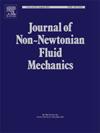Extensional rheology of elastoviscous aqueous PEO/PEG or DMS Boger fluids and weakly elastic alternatives for investigating viscoelastic flows and instabilities
IF 2.8
2区 工程技术
Q2 MECHANICS
引用次数: 0
Abstract
Boger fluids that exhibit a rate-independent shear viscosity (typically ∼ 1 Pa∙s = 1000x water viscosity) and elasticity measurable using torsional rheometers (modulus, relaxation time, or first normal stress difference) are considered as the realization of viscoelastic fluids described by the Oldroyd-B model. However, Boger fluids, conventionally formulated as dilute solutions of high molecular weight (Mw) polymers in relatively high viscosity solvents (or solutions of oligomers or lower Mw polymer), are unsuitable for emulating polymeric fluids used in coating formulations that are lower in viscosity, appear inelastic in torsional shear rheometry, and yet appear prone to viscoelastic instabilities. Therefore, Dontula, Macosko, and Scriven (DMS) (AIChE J, 1998) chose to create an alternative model of elastic fluids by dissolving ultrahigh molecular weight (UHMw) poly(ethylene oxide) (PEO) in an aqueous solution of its lower Mw analog, often referred to as poly(ethylene glycol) or PEG. Even though numerous studies of printing and coating flow instabilities use this aqueous PEO/PEG or DMS Boger fluids as model viscoelastic fluids, only a few explicitly measured elastic properties, especially using relaxation time, and hardly any characterized extensional rheology. In this contribution, we recreate the DMS Boger fluids to examine their elasticity and extensional rheology response using dripping-onto-substrate (DoS) rheometry that relies on an analysis of capillarity-driven pinching dynamics. Though the aqueous PEG solution is often treated as a viscous and Newtonian solvent, we discover that in DoS rheometry, both the PEG solution and the DMS Boger fluid display power law response followed by elastocapillary, in contradiction with the assumptions and the response expected of the Oldroyd-B model. Furthermore, the solution of entangled PEG chains influences specific viscosity, pinching dynamics, and measured extensional rheology response in striking contrast with Newtonian solvents of the same viscosity. Lastly, we describe the possibility of using dilute, aqueous solutions of UHMw PEO as model viscoelastic fluids for coating flows, for both elasticity and extensional viscosity can be determined using DoS rheometry. Due to their water-like viscosity, the aqueous PEO solutions appeal as model fluids that have elasticity, emulate Newtonian fluids in the early stages of pinching, and have a relaxation time tunable by changing polymer Mw or concentration.

用于研究粘弹性流动和不稳定性的弹性粘水性 PEO/PEG 或 DMS 博格流体的扩展流变学以及弱弹性替代品
博格流体具有与速率无关的剪切粘度(通常为 ∼ 1 Pa∙s = 1000x 水粘度)和可通过扭转流变仪测量的弹性(模量、弛豫时间或第一法向应力差),被认为是奥尔德罗伊德-B 模型描述的粘弹性流体的实现。然而,传统的 Boger 流体是高分子量 (Mw) 聚合物在相对高粘度溶剂中的稀释溶液(或低聚物或低 Mw 聚合物溶液),不适合模拟涂料配方中使用的聚合物流体,这些流体粘度较低,在扭转剪切流变仪中显示为非弹性流体,但却容易出现粘弹性不稳定性。因此,Dontula、Macosko 和 Scriven (DMS) (AIChE J,1998 年)选择通过将超高分子量(UHMw)聚环氧乙烷(PEO)溶解在其低 Mw 类似物(通常称为聚乙二醇或 PEG)的水溶液中,来创建弹性流体的替代模型。尽管许多关于印刷和涂层流动不稳定性的研究都使用这种 PEO/PEG 或 DMS 博格水溶液作为粘弹性流体模型,但只有少数研究明确测量了弹性特性,特别是使用弛豫时间,而且几乎没有研究表征了延伸流变学。在本文中,我们重新创建了 DMS Boger 流体,并使用依赖于毛细管驱动的捏合动力学分析的滴入基底(DoS)流变仪来研究它们的弹性和延伸流变响应。虽然 PEG 水溶液通常被视为粘性牛顿溶剂,但我们发现在 DoS 流变仪中,PEG 溶液和 DMS 博格流体都显示出幂律响应,随后出现弹性毛细管,这与 Oldroyd-B 模型的假设和预期响应相矛盾。此外,纠缠的 PEG 链溶液会影响比粘度、捏合动力学和测量到的延展流变响应,这与相同粘度的牛顿溶剂形成了鲜明对比。最后,我们介绍了使用 UHMw PEO 稀水溶液作为涂布流模型粘弹性流体的可能性,因为弹性和延伸粘度均可通过 DoS 流变仪测定。由于 PEO 水溶液具有类似于水的粘度,因此可以作为具有弹性的模型流体,在捏合的早期阶段模拟牛顿流体,并通过改变聚合物的 Mw 或浓度来调节松弛时间。
本文章由计算机程序翻译,如有差异,请以英文原文为准。
求助全文
约1分钟内获得全文
求助全文
来源期刊
CiteScore
5.00
自引率
19.40%
发文量
109
审稿时长
61 days
期刊介绍:
The Journal of Non-Newtonian Fluid Mechanics publishes research on flowing soft matter systems. Submissions in all areas of flowing complex fluids are welcomed, including polymer melts and solutions, suspensions, colloids, surfactant solutions, biological fluids, gels, liquid crystals and granular materials. Flow problems relevant to microfluidics, lab-on-a-chip, nanofluidics, biological flows, geophysical flows, industrial processes and other applications are of interest.
Subjects considered suitable for the journal include the following (not necessarily in order of importance):
Theoretical, computational and experimental studies of naturally or technologically relevant flow problems where the non-Newtonian nature of the fluid is important in determining the character of the flow. We seek in particular studies that lend mechanistic insight into flow behavior in complex fluids or highlight flow phenomena unique to complex fluids. Examples include
Instabilities, unsteady and turbulent or chaotic flow characteristics in non-Newtonian fluids,
Multiphase flows involving complex fluids,
Problems involving transport phenomena such as heat and mass transfer and mixing, to the extent that the non-Newtonian flow behavior is central to the transport phenomena,
Novel flow situations that suggest the need for further theoretical study,
Practical situations of flow that are in need of systematic theoretical and experimental research. Such issues and developments commonly arise, for example, in the polymer processing, petroleum, pharmaceutical, biomedical and consumer product industries.

 求助内容:
求助内容: 应助结果提醒方式:
应助结果提醒方式:


